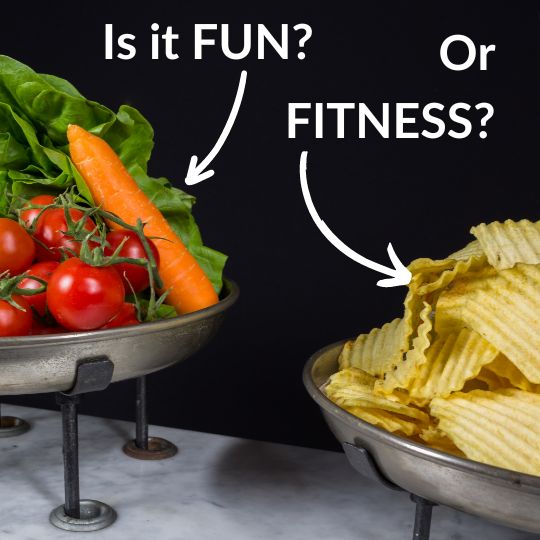Is your physical activity fun or is it fitness?
How you frame physical activity might affect how tiring it feels to you and the quality and quantity of your food choices afterward.
We humans are a complex, and often a confounding and contradictory species.
It turns out that how you perceive physical activity might influence how tiring you think it is (regardless of calories expended) and your food choices (both in terms of quality and quantity) afterward.
Years ago, research clearly demonstrated that our psychological perception of the health of a food influences our body’s handling of those calories and feelings of fullness, forever ending our ability to take the mind-numbingly simplistic energy balance equation seriously in the realm of human physiology. (We are not chemistry labs and all calories do not behave equally once we eat them and their processing can depend significantly on what we think we are eating.) (See “Mind Over Milkshakes” to get caught up on this.)
What Happens When You Choose Fun or Fitness
Recently, I came across some truly fascinating work showing the same thing with physical activity.
- People on stationary bikes cycled until the display indicated they burned either 50 calories or 250 calories. The displays were fake as researchers manipulated them to that all participants burned the exact same number of calories on the bikes, regardless of what the display showed. Those who believed they burned off more calories ate significantly more chocolate chip cookies. (McGaig, 2016)
- People on a fixed one-mile course on a college campus were put in two different conditions: exercise or fun. The exercise condition participants were told that the purpose was exercise. The fun condition participants were told that the purpose was to evaluate the clarity of music from an MP3 player at various points along the walking route. Afterward, participants went to an all-you-can-eat buffet. (The methodology of the researchers here is truly clever and fascinating, but I’m cutting to the chase to give you the result). When the focus was “exercise,” participants chose more hedonic sides (Coke and pudding), reported more exertion and were in a less positive mood.
- Same walk as in study #2 above but the framing conditions were either “exercise” or “fun” (sightseeing instead of music) and used a different dependent variable – a self-selected quantity of M&M chocolate candies at the completion of the walk. While completing a short form after the walk and after scooping out a self-selected amount of M&Ms, researchers surreptitiously weighed the amount of M&Ms. Participants in the “exercise” condition selected 372 calories of candy while those in the “fun” condition selected 166 calories of candy. (Werle, 2014)
This is incredible.
Our perception of our exercise efforts as a chore or work creates a sense of a license to eat higher calorie foods or just more food in general and we perceive it to be harder.
Funtensity wasn’t created based on science like this, but it is fascinating to see the positive effect that framing exercise as fun can have on perceived effort and subsequent nutrition choices as a result.
References
McCaig, 2016: https://pubmed.ncbi.nlm.nih.gov/27554186/
Werle, 2014: https://link.springer.com/article/10.1007/s11002-014-9301-6

